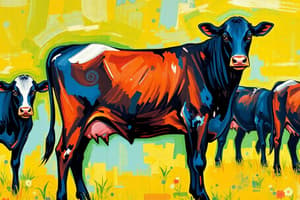Podcast
Questions and Answers
What is the primary cause of primary ruminal tympany, also known as frothy bloat?
What is the primary cause of primary ruminal tympany, also known as frothy bloat?
- Increased saliva production
- Reduced rates of digestion and ruminal passage
- Decreased protein content in the ruminal contents
- Entrapment of normal gases of fermentation in a stable foam (correct)
What is the effect of feeding on ruminal fermentation?
What is the effect of feeding on ruminal fermentation?
- It supplies nutrients for a burst of microbial fermentation (correct)
- It slows down microbial fermentation
- It reduces the production of soluble leaf proteins
- It reduces the release of small chloroplast particles
What is the role of salivary mucin in relation to bloat?
What is the role of salivary mucin in relation to bloat?
- It is an antifoaming agent (correct)
- It increases the release of small chloroplast particles
- It reduces the production of soluble leaf proteins
- It acts as a foaming agent
What is the pH at which the monomolecular layer around gas rumen bubbles has its greatest stability?
What is the pH at which the monomolecular layer around gas rumen bubbles has its greatest stability?
What is the type of bloat that occurs when free gas is separated from the ingesta?
What is the type of bloat that occurs when free gas is separated from the ingesta?
What is the percentage of death rate recorded in cattle grazing bloat-prone pasture?
What is the percentage of death rate recorded in cattle grazing bloat-prone pasture?
What is the factor that determines if bloat will occur?
What is the factor that determines if bloat will occur?
What is the annual mortality rate from bloat in dairy cows?
What is the annual mortality rate from bloat in dairy cows?
What is the primary factor that contributes to the susceptibility of animals to bloat?
What is the primary factor that contributes to the susceptibility of animals to bloat?
Which of the following legumes is known to cause bloat?
Which of the following legumes is known to cause bloat?
What is the likely reason why certain legumes, such as sainfoin, do not cause bloat?
What is the likely reason why certain legumes, such as sainfoin, do not cause bloat?
What is the typical stage of growth when leguminous bloat is most common?
What is the typical stage of growth when leguminous bloat is most common?
What is the likely cause of frothy bloat in feedlot cattle?
What is the likely cause of frothy bloat in feedlot cattle?
What is the typical timeframe for feedlot bloat to occur in cattle?
What is the typical timeframe for feedlot bloat to occur in cattle?
What is the effect of finely ground grain on foam stability?
What is the effect of finely ground grain on foam stability?
Which type of cattle is least commonly affected by frothy bloat?
Which type of cattle is least commonly affected by frothy bloat?
What is the primary characteristic of the skin over the left flank in severe cases of bloat?
What is the primary characteristic of the skin over the left flank in severe cases of bloat?
What is the typical time frame for death to occur after the onset of clinical signs in animals with bloat?
What is the typical time frame for death to occur after the onset of clinical signs in animals with bloat?
What is the characteristic of the rumen contents in secondary bloat?
What is the characteristic of the rumen contents in secondary bloat?
What is the main difference between free-gas bloat and frothy bloat on percussion?
What is the main difference between free-gas bloat and frothy bloat on percussion?
What is the result of an emergency rumenotomy in life-threatening cases?
What is the result of an emergency rumenotomy in life-threatening cases?
What is the typical finding in the cervical esophagus during necropsy?
What is the typical finding in the cervical esophagus during necropsy?
What is the purpose of using a larger bore instrument in emergency relief?
What is the purpose of using a larger bore instrument in emergency relief?
What is the recommended course of action if the cannula fails to reduce the bloat and the animal's life is threatened?
What is the recommended course of action if the cannula fails to reduce the bloat and the animal's life is threatened?
What is the characteristic of the liver during necropsy?
What is the characteristic of the liver during necropsy?
What is the primary method of diagnosing the cause of secondary bloat?
What is the primary method of diagnosing the cause of secondary bloat?
What is the purpose of passing a stomach tube of the largest bore possible?
What is the purpose of passing a stomach tube of the largest bore possible?
What is the recommended action if the bloat is not relieved quickly by the antifoaming agent?
What is the recommended action if the bloat is not relieved quickly by the antifoaming agent?
What is the effect of passing a stomach tube or trocarization on free-gas bloat?
What is the effect of passing a stomach tube or trocarization on free-gas bloat?
What type of oils are effective as antifoaming agents?
What type of oils are effective as antifoaming agents?
What is the dose of antifoaming agent effective in relieving bloat?
What is the dose of antifoaming agent effective in relieving bloat?
What is the purpose of incorporating dioctyl sodium sulfosuccinate (docusate) into an antifoaming agent?
What is the purpose of incorporating dioctyl sodium sulfosuccinate (docusate) into an antifoaming agent?
What is the effective dose of Poloxalene for treating legume bloat?
What is the effective dose of Poloxalene for treating legume bloat?
What provides short-term relief for cases of free-gas bloat associated with external obstruction of the esophagus?
What provides short-term relief for cases of free-gas bloat associated with external obstruction of the esophagus?
What is the minimum proportion of hay required in the diet to effectively reduce the risk of bloat?
What is the minimum proportion of hay required in the diet to effectively reduce the risk of bloat?
What type of pastures are more likely to cause bloat?
What type of pastures are more likely to cause bloat?
What is the most reliable method of preventing pasture bloat?
What is the most reliable method of preventing pasture bloat?
How often should an antifoaming agent be administered to prevent pasture bloat?
How often should an antifoaming agent be administered to prevent pasture bloat?
What is an alternative method of administering an antifoaming agent?
What is an alternative method of administering an antifoaming agent?
What type of antifoaming agents are available?
What type of antifoaming agents are available?
Flashcards are hidden until you start studying
Study Notes
Bloat
- Bloat is an overdistension of the rumenoreticulum with gases of fermentation, either in the form of a persistent foam mixed with ruminal contents (primary or frothy bloat) or free gas separated from ingesta (secondary or free-gas bloat)
- Predominantly a disorder of cattle, but also seen in sheep
- Susceptibility to bloat varies and is genetically determined
- Death rates as high as 20% in cattle grazing bloat-prone pasture
- Economic loss from depressed milk production in non-fatal cases and from suboptimal use of bloat-prone pastures
Etiology and Pathogenesis
- Primary ruminal tympany (frothy bloat) caused by entrapment of normal gases of fermentation in a stable foam
- Coalescence of small gas bubbles inhibited, intraruminal pressure increases, and eructation cannot occur
- Factors influencing foam formation: soluble leaf proteins, saponins, hemicelluloses, salivary mucin, and chloroplast particles
- Bloat-producing pastures are rapidly digested, releasing small chloroplast particles that trap gas bubbles and prevent coalescence
- Protein content and rates of digestion and ruminal passage reflect the forage's potential for causing bloat
- Legume forages like alfalfa and clover have a higher percentage of protein and are digested more quickly, making them prone to bloat
- Other legumes like sainfoin, crown vetch, and fenugreek do not cause bloat due to condensed tannins that precipitate protein and are digested more slowly
Clinical Signs and Lesions
- In frothy bloat, the skin over the left flank becomes progressively more taut, and in severe cases, cannot be "tented"
- Dyspnea, grunting, mouth breathing, protrusion of the tongue, extension of the head, and frequent urination
- Rumen motility does not decrease until bloat is severe
- In secondary bloat, the excess gas is usually free on top of the solid and fluid ruminal contents
- Tympanic resonance over the dorsal abdomen left of the midline
- Free gas produces a higher pitched ping on percussion than frothy bloat
- Distension of the rumen can be detected on rectal examination
- Necropsy findings: congestion and hemorrhage of lymph nodes, epicardium, and upper respiratory tract, compressed lungs, and intrabronchial hemorrhage
- Cervical esophagus is congested and hemorrhagic, while the thoracic portion is pale and blanched (the "bloat line" of the esophagus)
Diagnosis and Treatment
- Clinical diagnosis of frothy bloat is usually obvious
- Emergency rumenotomy may be necessary in life-threatening cases
- Trocar and cannula can be used for emergency relief, but a larger bore instrument is necessary in peracute cases
- Antifoaming agents can be administered through the cannula or orally
- In frothy bloat, passing a stomach tube of the largest bore possible is recommended
- Various antifoaming agents are effective, including vegetable oils, mineral oils, and dioctyl sodium sulfosuccinate (docusate)
Control and Prevention
- Prevention of pasture bloat can be difficult
- Management practices to reduce risk of bloat: feeding hay before turning cattle on pasture, maintaining grass dominance in the sward, or using strip grazing to restrict intake
- Hay must constitute at least one-third of the diet to effectively reduce risk of bloat
- Continual administration of an antifoaming agent during the risk period is the most reliable method to prevent pasture bloat
- Antifoaming agents can be administered orally, sprayed onto the pasture, added to feed or water, or incorporated into feed blocks
Studying That Suits You
Use AI to generate personalized quizzes and flashcards to suit your learning preferences.




